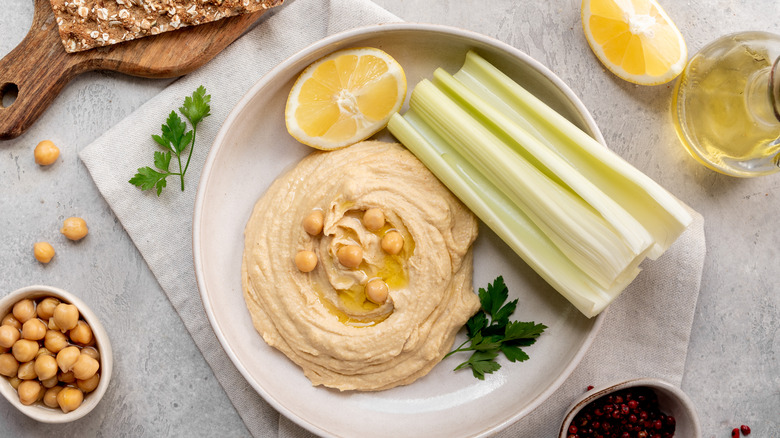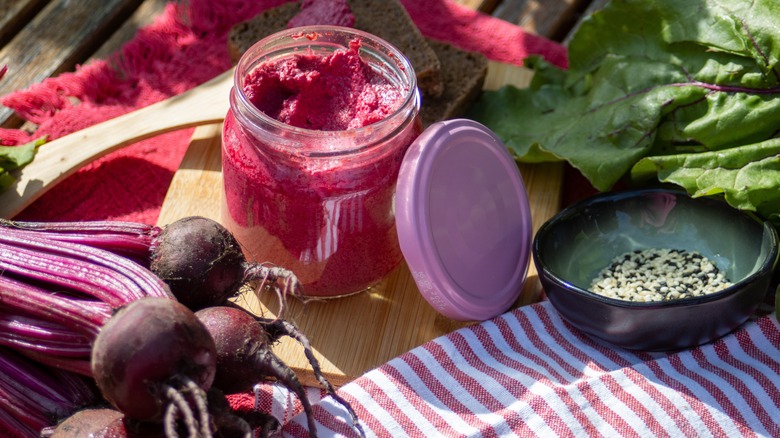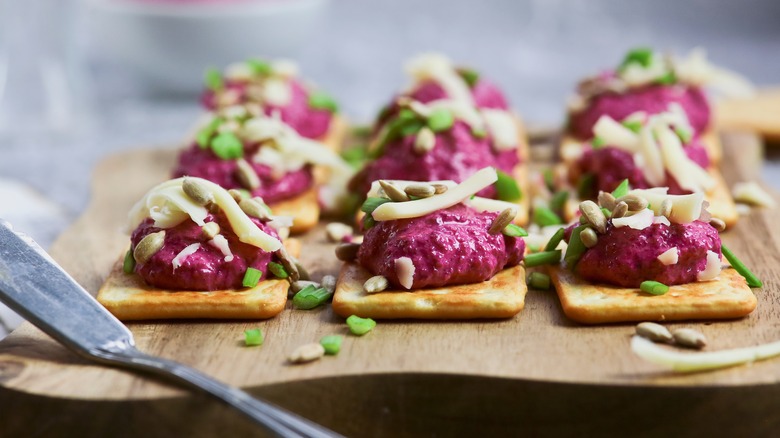Add This Veggie To Your Next Batch Of Hummus For A Bright Pop Of Color
What could beat a fresh batch of creamy hummus? Pink hummus, of course. While pink hummus is fabulous, artful, and just might keep your picky kids from turning their noses up to a spread of beans, don't use food dye to give it that vibrant pop of color — use beets instead.
In addition to enhancing the visual appeal of the classic Mediterranean bean dip, beets have a naturally sweet and earthy flavor that seamlessly integrates with the rich, savory taste of traditional hummus for added depth and complexity. That same folksy sweetness in beets also works as an equalizer, balancing the tartness of lemon juice and the umami-forward saltiness of tahini and chickpeas for a well-rounded and symmetrical tapestry of flavors.
Beyond its bright, grounding flavor and glamorous shade of purple-ish pink, beets are a nutrient-dense vegetable. By blending them into a plate of hummus, you're providing the spread with added vitamins, fiber, antioxidants, and digestion-improving properties. Seeing that traditional hummus is already teeming with protein and healthy fats, introducing beets to the mix certifies beet hummus as a bona fide flavor-forward superfood.
How to incorporate beets into hummus
Don't just daydream about beet hummus, get into the kitchen and make it! Although it might sound like a tricky process, it's easier than you might think, especially when you keep a few pointers in mind.
Before you begin combining and processing ingredients, thoroughly rinse your chickpeas and beets to remove any soil, dirt, or other contaminants that can disrupt the quality of the dish. Although it's not entirely necessary, removing the skins from the chickpeas facilitates a smoother, creamier final product. Simply pinch, pull, and discard. If you're feeling resourceful, fry the skins and use them as a crunchy beet hummus topper.
While you're taking the skins off the chickpeas, wrap your beets and foil and let them roast in the oven. Roasting the colorful root vegetables can soften them for easier and more seamless integration while deepening their flavor profile. Peel and remove the skin just like you did with the chickpeas to keep your hummus perfectly lump-free. Dicing them into smaller pieces makes blending them with chickpeas, hummus, tahini, and oil in a food processor less cumbersome. Et voilà — you now have all the tips you need for a perfect batch of beet hummus. Once prepared, store it in the fridge where it will stay fresh for up to four days.
Pairing beet hummus
We wouldn't judge you for spooning beet hummus straight from the bowl and enjoying it as it is. If you want to introduce it into a more comprehensive smorgasbord of snacks or use it in your favorite meals, there's no shortage of options. Thoughtfully place your colorful hummus within a mezze platter filled with Mediterranean gems such as dolmades, marinated olives, crusty, warm pita bread, and cucumbers. You can dip, lather, and dunk each ingredient into your pink, creamy chickpea centerpiece. Spread a layer of beet hummus across two toasty ciabatta buns before layering the bread with your favorite vegetables and a heaping portion of charred kebab chicken. This hearty, satiating sandwich is beaming with bright flavors accented by savory, umami-forward notes. Thin out beet hummus with vinegar and oil to create a creamy, decadent, full-flavored dressing for a classic Greek salad.
To jazz up beet hummus, blend garlic and shallots into the creamy amalgam for a satisfyingly familiar hit of allium goodness. Don't skimp on the herbs, either. Basil brings a touch of peppery sweetness while parsley imparts zippy notes of earthiness. Crumbling feta over the dish provides an unbeatable richness accented by undercurrents of vibrant zestiness. For a touch of heat that's bold but never brash, a few pickled jalapeños can go a long way.
Next time you're craving hummus, shake up traditions by bringing beets into the mix. Being both colorful and brightly flavored, beet hummus deserves a spot in your meal rotation.


